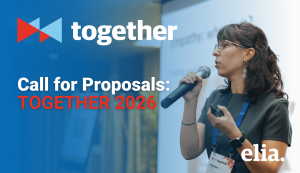In the run-up to Networking Days 2025 in Budapest, we are sharing a series of discussion articles that capture early reflections from the ELIA Board of Directors and the Content Committee on this year’s programme. These meetings are about opening space for reflection, raising the difficult questions, and sparking dialogue that will continue with even greater depth at the event itself.
Our second discussion turned to Session 2: Opportunity Knocks – What’s the Real Price of Entry? Dealing with the illusion of no-cost AI services and preserving your value.
Are your localisation clients under increasing pressure to incorporate AI into their workflows in order to dramatically reduce costs? Have they discovered that the solutions available are failing to meet their expectations? And how can we understand client needs to create meaningful offers that help them reach their goals, while ensuring providers also share in the value?
The Price of Entry for Clients
At first glance, AI can appear to be a low-cost solution. But the group questioned whether clients are truly aware of what they are giving up, and what costs are quietly being shifted onto their own shoulders.
Anu Carnegie-Brown (ACB): “Today’s topic is about the illusion that AI solutions are free or cheaper than human solutions. And how do we, as providers of human solutions, make sure that we still have a piece of the pie in this kind of environment?”
Nenad Andricsek (NA): “People usually don’t think about their own time, how much it is worth. And that might be an interesting topic to talk about.”
Alina Birsan (AB): “I have clients who are lawyers using DeepL for contracts. They have the impression that it’s less of a cost, but they don’t take into consideration their rate per hour. That’s billable time which becomes an invisible cost.”
The group reflected that AI adoption is often being driven from the top of organisations, with CTOs and CIOs pushing wide-scale adoption across company workflows. This means localisation departments may not always be the ones setting expectations, leaving LSPs with little influence over key decisions.
Milena Spelta Parenti (MSP): “We don’t have a say when very large companies push for lower costs. Sometimes we are simply the small piece at the end of the chain.”
Clients may view AI as a cost-saving shortcut, but often the burden simply shifts elsewhere in the workflow. Time, quality and brand impact carry hidden costs that are rarely accounted for in budget calculations.
💡 Discussion prompt: Do your clients fully understand the hidden costs of AI, and how can LSPs make those costs visible without sounding defensive?
The Price of Entry for LSPs
While buyers are struggling to grasp the hidden costs of AI, providers are facing their own challenges. The panel reflected on what it takes (or costs) for LSPs to remain competitive in a market increasingly shaped by technology companies.
MSP: “Our new competitor is not another LSP, it’s some tech companies giving customised MT. They asked us for a price reduction without giving us the possibility of checking the output.”
Stéphane Hue (SH): “If we remain in a position where clients see us only as post-editors, then their expectation is to reduce the price. If we have the opportunity of positioning ourselves as providing a larger scope of services, not just post-editing, then it is better. But for that, clients need to perceive us as technology providers as well.”
MSP: “We have to understand what the market wants of us; for instance, the use of CMSes drastically reduced the need for classic layout jobs. Therefore, we have downsized our DTP department. We once had quite a large team, but demand has dropped and roles have been cut back. Today other roles are more crucial as of now, like prompt engineering, just to name the most obvious.”
ACB: “So if I’m trying to sum up, are we saying that the old linguistic work is reducing in volume, so we might need to let go of some of the people who’ve been involved in those operations. The new opportunities are maybe in advising clients and really partnering with them to create new solutions and workflows.”
For LSPs, the price of entry is not only about investing in tools. It is also about repositioning themselves in a crowded value chain where technology providers often set the pace and expectations.
💡 Discussion prompt: What is the true price of entry for LSPs: technology investment, new roles, or a redefined position in the market?
Misaligned Expectations
The conversation turned to a growing tension: what clients think they are buying from AI does not always match what the tools can actually deliver.
SH: “If it’s high-value items, there’s an investment in high-value localisation. If it’s low-value items such as cheap garments, there’s no way you can invest in a fully fledged, well-crafted translation. Those products are about volume, flooding the market, and the cost of translation has to stay very low. On the other hand, if you sell luxury items, you will invest much more, because every single piece represents significant value. What we are facing is a market that is becoming more and more segmented, and we need to provide segmented solutions. AI is moving in that direction, not very precise but often considered good enough and fit for purpose.”
AB: “We have the impression that luxury goods have good localised content, but I came across information that even prestigious brands are using machine translation and post-editing. That is not really the perfect process you would expect for the quality of localised content associated with such brands.”
ACB: “At the moment it’s very attractive and very available and cheap-looking, but once you’ve got a captive audience, is the pricing going to change? We haven’t even touched upon the indirect costs of what this is doing to energy and the environment.”
Participants also raised the difficulty of predicting return on investment, both for clients experimenting with AI and for LSPs deciding whether to invest in new tools, retrain staff, or restructure. In both cases, managers face pressure to deliver short-term savings while the long-term costs remain uncertain.
When “good enough” becomes the standard, what happens to quality, and who takes responsibility when clients discover the shortcomings?
💡 Discussion prompt: How should LSPs respond when client expectations are unrealistic: adapt to them, challenge them, or let clients face the consequences?
Where Human Oversight Still Matters
Despite enthusiasm for automation, the group highlighted that there are still areas where compromise is impossible.
AB: “In healthcare or law, you cannot take risks. Human oversight is essential.”
AB: “The biggest clients, including EU institutions, agreed that they need to understand the risks of relying on an automated process without responsibility. They understood that they needed human touch. They cannot rely only on machines, especially for regulated content.”
ACB: “We all know that large language models work best in English at the moment. For many other languages the quality is not the same, or the cost of producing them is much higher.”
MSP: “Clients might think they are saving costs, but if the output fails in a critical area, the damage is far more expensive. That’s why we cannot remove human review from the equation with no second thought, that is clients need to carefully analyse where full AI translations can be used and where a professional is needed.”
NA: “Some sectors will always need us. If you are dealing with regulation, safety, or people’s lives, there’s no way AI can fully replace human involvement.”
AI may offer speed and scale, but in high-stakes contexts the risks of miscommunication are simply too great. This reinforces the continuing need for human expertise, even in an era of automation.
💡 Discussion prompt: Where should LSPs draw the line between AI-driven efficiency and human-critical quality, and how do we explain that line to clients?
Looking Ahead
Finally, the discussion looked to the future. If AI is reshaping the rules of the industry, what should providers do to ensure they remain relevant?
NA: “The roles of the future may be about managing AI outputs at scale, catching errors and knowing how to use the technology.”
AB: “Human expertise is going to be more and more expensive because we’re going to have fewer and fewer professionals in this industry. They’re leaving because they cannot sustain their lives.”
SH: “If we remain in a position where clients see us only as post-editors, then their expectation is to reduce the price. We need to position ourselves as providing a broader scope of services, not just post-editing.”
ACB: “The challenge is that technology providers can invest without thinking of return, because they are funded differently. For us, every investment has to be sustainable.”
MSP: “At the end of the day, we need to remind clients why language matters. Technology cannot carry the weight of culture and nuance on its own. Such an approach is still risky and might result in losing market shares.”
The real price of entry may not be financial at all. It may be about reshaping expectations, changing perceptions, and carving out new roles in the value chain. Those who succeed could find themselves not diminished, but strengthened.
💡 Discussion prompt: What new roles and services could emerge for LSPs as AI reshapes localisation?
At ND25 Session 2: Opportunity Knocks – What’s the Real Price of Entry? we’ll take these reflections further in an open, peer-driven conversation.
In a landscape where AI promises speed and low cost, the real challenge is uncovering what those promises truly cost clients and providers, and how LSPs can still claim their share of value. The future will not be defined only by tools, but by how we position ourselves within new workflows, new expectations, and new roles.
What’s your view? Share your thoughts now on LinkedIn, and let’s continue the discussion in Budapest, 22–23 September 2025.




